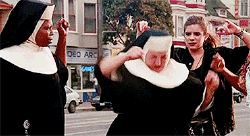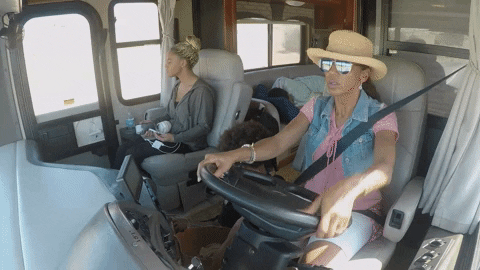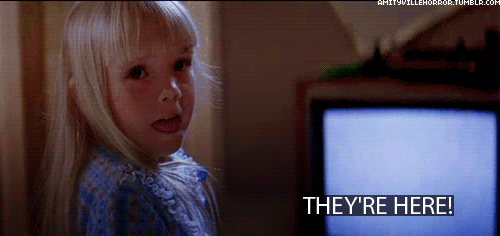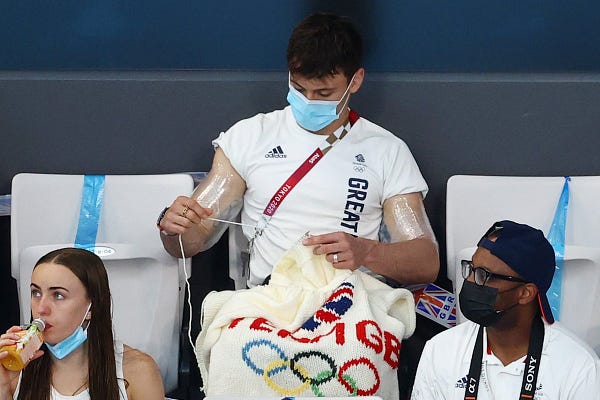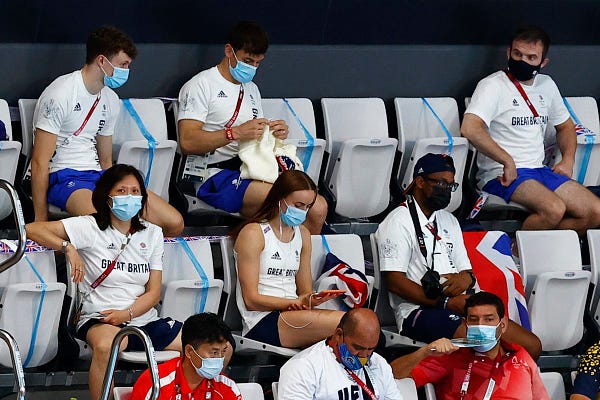Caregiving Crisis: Back In The Habit
We're back from Tired Mom Summer! We're still tired but we have a LOT to talk about. Women gained jobs in July, paid leave could actually happen aaand did I wear shorts?
Hey everyone,
Welcome back to Caregiving Crisis! On our last episode, we declared it was Tired Mom Summer and called a hiatus for the month of July.
The goal was to find time to pause, reflect, power up and get ready for the fall. The school, the work, the…caregiving infrastructure crisis. It was a purposeful break, and I had my trusty list of official TMS Content Recommendations from many of you as a guide.
The break was glorious. Some snapshots:
Beach time, pool time, car time, ice cream time. And reading time. Well, reading Bridgerton time. Despite my best intentions and all of the plans I had to read up on So Many Things, I didn’t. Normally I’d think ‘ugh why didn’t I make more use of this break,’ me being utterly dependent on productivity and all. But you know what? I’m glad I got sucked in by the Bridgerton book series. It’s sappy, romantic, delightful and has nothing to do with reality. Bring it on. I’ve been making my way through all eight books, on the beach in Delaware, when I have a few minutes break anywhere around home in New Jersey, flying over the midwest. At one point, I was on a plane ride home from visiting family in Ohio and I glanced at the book of the woman next to me. We were both reading Bridgerton. Through our masks, we acknowledged our devotion to the series and how we needed the mind break. She said her friends were passing the books around to each other, everyone needing to indulge in some ridiculousity1 these days. Truth.
So be gentle with yourself as the summer wanes and life gets (more) hectic (again). Carve out the break where you can, trade some ‘shoulds’ for ‘definitely nots’ and ask yourself what do you need now to fortify yourself?
We’ve been through a lot in the pandemic and for many months and years before that. There’s great momentum for progress ahead (see below in news) and uncertainties loom (Delta. Get a vaccine or browbeat others into doing so!), so continue to get some rest and pull back so we can push forward.
Thank you for being here and welcome to our new joiners. Please read more about why I started this newsletter (TLDR: to inform a population deeply affected by a crisis that otherwise has no time to keep up.) I hope Caregiving Crisis informs you and gives you a bit of a break, too. Have a caregiving story or know someone who does? Please message me for inclusion in a future issue. Hang in there and see you soon.
And be sure to read to the end, where I have the Big Reveal about whether or not I wore shorts during Tired Mom Summer. Can you stand it?!
What To Know About the Caregiving Crisis This Week
NEWS WATCH: ROUNDUP — Keeping tabs on legislation, regulation and conversation:
WOMEN SEE OUTSIZE JOB GAINS — The July jobs report out this morning showed a massive 943,000 net jobs added last month and women accounted for about 70% of the gains, the 19th reports. This is the second straight month with a net gain of nearly 1 million jobs, and women making up more than half of the gains. Hospitality, which employs largely women, drove gains. The overall unemployment rate edged down to 5.4%, and improved to 5% from 5.5% for women. But looking at it by demographic:
Black women still have the highest unemployment rate at 7.6%
Latinas are at 6.7%
White women's unemployment is 4.5%
Asian women are at 4.9%
New data from the BLS and analyzed by the Brookings Institution shows that during the pandemic, child care really was a second full-time job for many moms of young kids. The 19th reports that, on average, moms with kids 12 and under spent about 8 hours a day on direct or indirect child care last year. They also worked an average of six hours on weekdays. Dads spent about five hours a day on childcare and worked eight-hour days. One bright spot, the 19th says: fathers of kids between the ages of 5 and 12 were the only group of parents to increase the amount of time they were spending on direct care.
INFRASTRUCTURE BILL SET TO PASS SKIMPS ON CAREGIVING — U.S. Senators are expected to vote Saturday on a bipartisan infrastructure bill that comes far short of Pres. Joe Biden's initial proposal in March. That plan, the American Jobs Plan, included caregiving as infrastructure, igniting significant criticism from Republicans. In all, the bipartisan bill up for approval calls for $550 billion in new federal investments on things like roads, bridges and other concrete infrastructure over five years (CNN).
Pressure is building on the philanthropic world to step up. Some eight grant makers are joining to form the CARE Fund, a five-year $50 million investment aimed at building "a comprehensive and equitable care infrastructure," writes Carla Thompson Payton, of the W.K. Kellogg Foundation, in The Chronicle of Philanthropy. “We all know our care infrastructure is broken. We cannot let this moment pass without doing all we can to fix it and expand who has access to quality, affordable care and who does not,” she writes. Partners in the Care for All with Respect and Equity Fund (CARE) include Pivotal Ventures, the Ford Foundation, Robert Wood Johnson Foundation and more.
MOMENTUM BEHIND PAID LEAVE: DADS AND BUS TOUR — The 19th reports that "a wave of dads pushing for paid family leave policies has taken the issue from a non-starter to one that could potentially become national policy." Dads like Rep. Colin Allred, D-Texas — who in 2019 became the first member of Congress to take paternity leave (publicly) — recognize its value and, experts say, are giving other men cover to take leave and advocate for it. Plans before Congress could provide 12 weeks of leave for all parents, and many workers would see two-thirds of their wages if covered. Fall passage is possible, say advocates like Dawn Huckelbridge, the director of Paid Leave for All, a national advocacy organization pushing for federal paid family and medical leave. The group has embarked on a 14-state bus tour over this week and next to mobilize and call attention to the value of providing paid leave to American workers.
The U.S. is woefully behind all other industrialized nations in not providing national paid leave. Ms. Magazine, which covered a DC rally stop this week, said 84% of U.S. voters support such a measure.
“My friends, this is about family,” House Speaker Nancy Pelosi said at the stop. “It’s about children. It’s about time. It’s about time that we get all of this done.”
OLDER WOMEN LOOK AROUND AND SAY ‘NOPE’ TO CAREGIVING — Flagging an interesting caregiving trend that may be bubbling up, even in your own circles. The New York Times reports that older women seem to have had it with a lifetime of caregiving. Single older women seem to be reluctant to live with or even marry partners because they don't want to be caregivers in their later years. (I don't blame them at all. Hi to my husband! Take your vitamins today?😘 ) The trend of "LAT" — "living apart together" has couples in committed romantic relationships without sharing, or planning to share, a home. A rising divorce rate and "evolving social norms" are giving rise to the trend, experts say. Also, women just don’t want to anymore.
“A big attraction of LAT is to avoid the potential responsibility of being a full-time caregiver,” said Ingrid Arnet Connidis, an emerita sociology professor at Western University in London, Ontario. “Women cared for their children, parents and spouse, and want to avoid getting into these traditional gender roles.”
Bottom line: We’ll see what happens in Washington with caregiving in the infrastructure bill when/if it comes up. Passing paid leave would be a huge boost to elevating the importance of caregiving in the national discourse — and perhaps if we can demonstrate its impact, we’ll be able to win more support for other pieces of the infrastructure pie.
EQUAL PAY DAY FOR BLACK WOMEN— This week marked Equal Pay Day for Black Women, who typically earn 63 cents to the dollar that white men make. The date is largely symbolic but it shows how it takes Black women until Aug. 3 — or a total of 579 days — to earn what white men make in 365 (CNBC). Black women are more likely to be single parents and more likely to be their family’s main income source. The caregiving crisis has had an outsized toll on their jobless rates, which have been higher than those of whites during the pandemic.
The pay gap in the form of cents on each dollar compounds, to the tune of $2,009 a month or $24,110 a year. In a worker’s lifetime the differences are astounding, as headlines captured this week. Here’s CNBC:
These disparities don't just happen in isolation, reports Fortune.
“The issue of equal pay is not just a woman's issue because it trickles down into our families and into our communities, and it trickles down into our overall economy,” said Shannon Williams, the director of Equal Pay Today, a project of Equal Rights Advocates.
According to the National Partnership for Women & Families, if the gender pay gap were eliminated, on average, a Black woman working full-time and year-round would have enough money to:
pay for over two and a half years of childcare
afford more than two and a half extra years of tuition and fees for a four-year public university
pay for 22 more months of rent
The 19th reports a new study shows a lack of leadership opportunities for Black women may be a contributing factor. Pay inequity and barriers to inclusion can keep Black women from advancing. Changing work culture will help. One researcher who wrote a book about racial inequity in the workplace told the 19th that there's an invisible labor she calls "the inclusion tax." Unceasing stressors for workers of color in predominantly white environments can hurt Black women's trajectories as they navigate withstanding subtle racism or "work out whether or not to address it."
Bottom line: We can't get everyone on more even-footing — with better pay — if we don’t change work culture. And we can’t change work unless we change caregiving culture. Glad to see news this week that the SEC is expected to approve Nasdaq's proposal to boost corporate board diversity as soon as next week (Bloomberg). Getting more diverse voices at the top will help.
WHAT'S YOUR RISK BUDGET, EMILY OSTER ASKS — Parenting data guru Emily Oster says she's thinking through her own priorities and risk tolerance as she continues to navigate parenting in the Covid-19 era. The economist and Brown University professor talked this week with togetherness space for moms MamaDen, timed with the release of her new book "The Family Firm," a "data-driven guide to better decision making in the early school years."
Oster offers up the Four F's framework for decision-making: Frame the question, fact find, final decision and follow up. For her, lately, it's putting a layer of risk across all of those to determine what she and her family are comfortable with. "What are the things you want to spend your risk points on?" she says to ask yourself. For example, she likes to "spend" her points on going to her office, teaching her students in person. Her husband goes to work in-person too, and their kids go to school. They don't eat at restaurants inside, she said, and that's a trade off. To keep her decisions in check, she said each Saturday her kids get Covid testing following their violin lessons. "It has proved for us to be a very reassuring thing," she said.
Bottom line: This decision-making is exhausting. Vaccines for younger kids cannot get here soon enough. Be safe and get vaxxed.
LET’S DISCUS OLYMPIC MOMS (SOMETIMES THE PUNS TAKE OVER AND I AM SIMPLY THEIR VESSEL2) — The Olympics wrap up this weekend — and Paralympics start soon — and wow, what a Games it has been for moms and caregivers3. These topics had already been elevated in the public discourse during the pandemic, and media were certainly ready to highlight issues surrounding these caregiver-athletes this cycle. Conditions for them certainly aren't far from perfect - but they're pushing for change and the media is giving it the attention it rightly deserves. NPR has a well-reported story about the obstacles these mom-athletes face, featuring Mandy Bujold, a Canada boxer and new mom who had to fight the International Olympic Committee because she was on maternity leave during events the committee used to adjust its rankings. That effectively disqualified her so she appealed to the Court of Arbitration for Sport and won. She told NPR she may not have clinched a gold but she won "the bigger battle for maternal rights."
"The more that we can have this conversation, the more that sport organizations start adding rules to protect the female athletes when they do take that needed time off for maternity leave," Bujold said. "I think it's going to become more of a norm that mothers are competing at the highest level."
The Washington Post has a deeply reported story (thousands of words!) about Olympic moms — their history, how they train, plan for births, and their struggles. The conclusion is that athlete moms are now celebrating and embracing their dual roles, thanks in part to big names like Allyson Felix who are bringing light to the issue.
It's summed up nicely in the headline.
Felix, the most decorated female Olympian in track and field history, is "at the forefront of this fight for equity," as NPR put it. She cut ties with Nike after it tried to cut her pay after she became a mom. She's now with Athleta and spearheaded a $200,000 grant to pay for childcare for moms at the games.


Still, be careful not to idealize "Olympian 'Supermoms,'" reads a New York Times opinion piece. We can celebrate motherhood in elite sports, but it does obscure reality, says opinion writer Lindsay Crouse.
“No one pretends that combining motherhood with high-level athletic competition isn’t fundamentally hard, nor that the athletes who manage to do so are anything but inspiring. Still, mothers need support, not just cheers,” Crouse writes.
Bottom line: More talking, more normalizing! This is how we push for better support for caregivers across all walks of life. Trying to avoid some sort of Olympic analogy but nope, I’m doing it — we can go for the gold thanks to these athletes and their very public portrayals of their struggles.
Tired Mom Summer Follow-Up
DID I END UP WEARING SHORTS? — I’ll let Johnny Rose answer.
The three sentences in June’s Tired Mom Summer roundup discussing whether I’d *finally* wear shorts generated the most feedback we’ve ever gotten at CC.4 Sooo, I had to follow up. The short answer (ha!) is yes, I did. Kind of. I got really into bike shorts (with pockets) and wore them walking, doing yard work, nervously watching my son-on-his-training-wheels go too close to the curb. Like all the time. But mostly around the house. They’re not ‘wear out on the town’ shorts (are any shorts??) — but they’re something.
Also I must apologize to the Amazon jumpsuits/overalls that I prematurely disparaged in the TMS roundup. I thought they would solve my shorts dilemma and bring me peace in this world, being easy and breezy but not actually shorts OR a dress. I said in the last issue I fell in love with them but then swore them off because they were shoddily made. Welp, I realized reinforcing some buttons was all it took. I’m totally on team Amazon faux-linen overalls. Who knew!
Bottom line: Pandemic fashion, never leave us.
Signing off
Thanks, as always, for reading. Please send feedback, links to Amazon jumpsuits, gifs or a note so you’re not screaming into the void. If you found value in Caregiving Crisis, please consider sharing with a friend.
Caregiving Crisis is a newsletter written by Emily Fredrix Goodman. We aim to publish every other week but other things may get in the way.
Ridiculousity is my friend Cristina’s word and I love it. Go forth and use it. Shout out to CRM and good luck in NOLA!
Also for knitting. We adore you, Tom Daley! Giphy, can you hurry up and get me some Daley knitting gifs? Come ON. His colorwork is ::chef’s kiss::.

